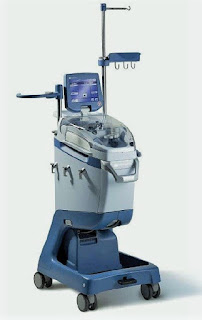Ebstein’s Anomaly
-A rare congenital cardiac
abnormality.
-The septal and posterior cusps of
the tricuspid valve are displaced downwards and are elongated, such that a
varying amount of the right ventricle effectively forms part of the atrium. Its
wall is thin and it contracts poorly. The remaining functional part of the right
ventricle is therefore small.
-The foramen ovale is patent, or
defective, in 80% of cases.
-The degree of abnormality of right
ventricular function, and the size of the ASD, are probably the main determinants
of the severity of the condition, which varies considerably.
-The right ventricular systolic
pressure is low, and the RVEDP is elevated. Tricuspid incompetence can occur.
-There may be a right to left shunt,
with cyanosis, on effort, and pulmonary hypertension, and right heart failure
may supervene.
-The natural history of the disease
is very variable. Fifty percent of cases present in infancy with cyanosis, and
42% die in the first 6 weeks of life.
-In those who survive to adulthood,
symptoms may be precipitated by the onset of arrhythmias, or by pregnancy. A
few patients remain asymptomatic, even as adults, although once symptoms
develop, the disability can increase rapidly.
-A cardiothoracic ratio of ≥ 0.65 is
a better predictor of sudden death than the symptomatic state, and those who
developed atrial fibrillation died within 5 years. It has therefore been
suggested that tricuspid surgery should be undertaken before the cardiothoracic
ratio reaches 0.65.
Preoperative Abnormalities:
1. There may be a right to left
shunt, with dyspnea and cyanosis at rest, or on moderate exertion.
Alternatively, the patient may be asymptomatic.
2. Episodes of tachyarrhythmias
occur in 25% of patients. Some provoke syncopal attacks.
3. The ECG may show varying
abnormalities, including large peaked P waves, a long P–R interval,
Wolff–Parkinson–White syndrome, RBBB, and right heart strain. Paroxysmal
supraventricular tachycardia occurs in 15%, usually because of the presence of
WPW syndrome.
4. Chest X-ray may show
cardiomegaly, with a prominent right heart border, and poorly perfused lung
fields.
5. Paradoxical systemic embolism and
bacterial endocarditis may occur.
6. Many other lesions of the
tricuspid valve or right ventricle may mimic Ebstein’s anomaly, therefore the
discriminating clinical and echocardiographic features for correct diagnosis
have been enumerated.
Anesthetic Problems:
These will depend upon the anatomical
abnormality, the degree of right to left shunt, and the presence or absence of
right heart failure.
1. Induction time is prolonged,
because of the pooling of drugs in the large atrial chamber.
2. Intracardiac catheter insertion
may be hazardous because it can provoke serious cardiac arrhythmias.
3. Air entering peripheral venous
lines or any open veins at subatmospheric pressure may cause paradoxical air
emboli.
4. Tachycardia is poorly tolerated
because of impaired filling of the functionally small right ventricle.
5. Hypotension may increase the
right to left shunt if present.
6. Hypoxia causes pulmonary
vasoconstriction, which also increases a right to left shunt.
7. There is a risk of bacterial
endocarditis, especially if a CVP line is in place.
8. Deterioration may occur in
pregnancy because of a decrease in right ventricular function, and an increase
in blood volume and cardiac output, or with the onset of arrhythmias.
Management:
1. The severity of the lesion must
be assessed. In the presence of maternal cyanosis or arrhythmias during
pregnancy, there should be close monitoring of both mother and fetus.
Deterioration may occur, despite previous successful pregnancies.
2. Treatment of heart failure and
arrhythmias.
3. Antibiotic prophylaxis against
bacterial endocarditis.
4. If a CVP is used for monitoring,
its tip should be kept within the superior vena cava. The use of intracardiac
catheters should probably be avoided.
5. Techniques should aim to minimize
tachycardia and hypotension.
6. Oxygen therapy increases pulmonary
vasodilatation. Long-term maternal therapy is required during pregnancy from 14
weeks, to treat fetal hypoxia that is demonstrated by umbilical venous blood
gases.
7. Several anesthetic techniques
have been described. A two-catheter epidural technique can be used for vaginal
delivery to minimize hypotension. Bupivacaine doses must be fractionated and
saline rather than air used to site the epidural, to avoid paradoxical air
emboli. Cesarean section under general anesthesia, preceded by fentanyl, and a
neurolept analgesic technique for hysterectomy, have been described.

































